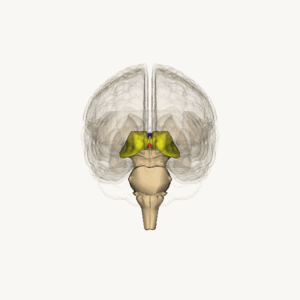Thalamus
Original Editor - Lucinda hampton
Top Contributors - Lucinda hampton, Kirenga Bamurange Liliane, Uchechukwu Chukwuemeka, Vidya Acharya, Rucha Gadgil and Mason Trauger
Introduction[edit | edit source]
Nestled beneath the cortex, a pair of egg-shaped structures called the thalamus has also gotten bigger and more complex throughout evolution 9like the cortex), and its wiring became much more intricate as mammals diverged from reptiles. The thalamus (from the Greek thalamos or inner chamber) transmits 98 percent of sensory information to the cortex, including vision, taste, touch and balance; the only sense that doesn’t pass through this brain region is smell. The thalamus also conducts motor signals and relays information from the brain stem to the cortex, coordinating shifts in consciousness such as waking up and falling asleep[1].
Image: Animation of rotation, brainstem and thalamus.
Functionally, the thalamus divides into five major functional components as:
- Reticular and intralaminar nuclei dealing with arousal and pain regulation
- Sensory nuclei regulating all sensory domains except olfaction
- Effector nuclei governing motor language function
- Associative nuclei connoting cognitive functions
- Limbic nuclei encompassing mood and motivation[2]
Sub Heading 2[edit | edit source]
Sub Heading 3[edit | edit source]
Resources[edit | edit source]
- bulleted list
- x
or
- numbered list
- x
References[edit | edit source]
- ↑ Knowable magazine A long-overlooked brain region may be key to complex thought Available from:https://knowablemagazine.org/article/mind/2018/long-overlooked-brain-region-may-be-key-complex-thought (accessed 26.12.2020)
- ↑ Torrico TJ, Munakomi S. Thalamus.2019 Available from:https://www.ncbi.nlm.nih.gov/books/NBK542184/ (accessed 26.12.2020)







